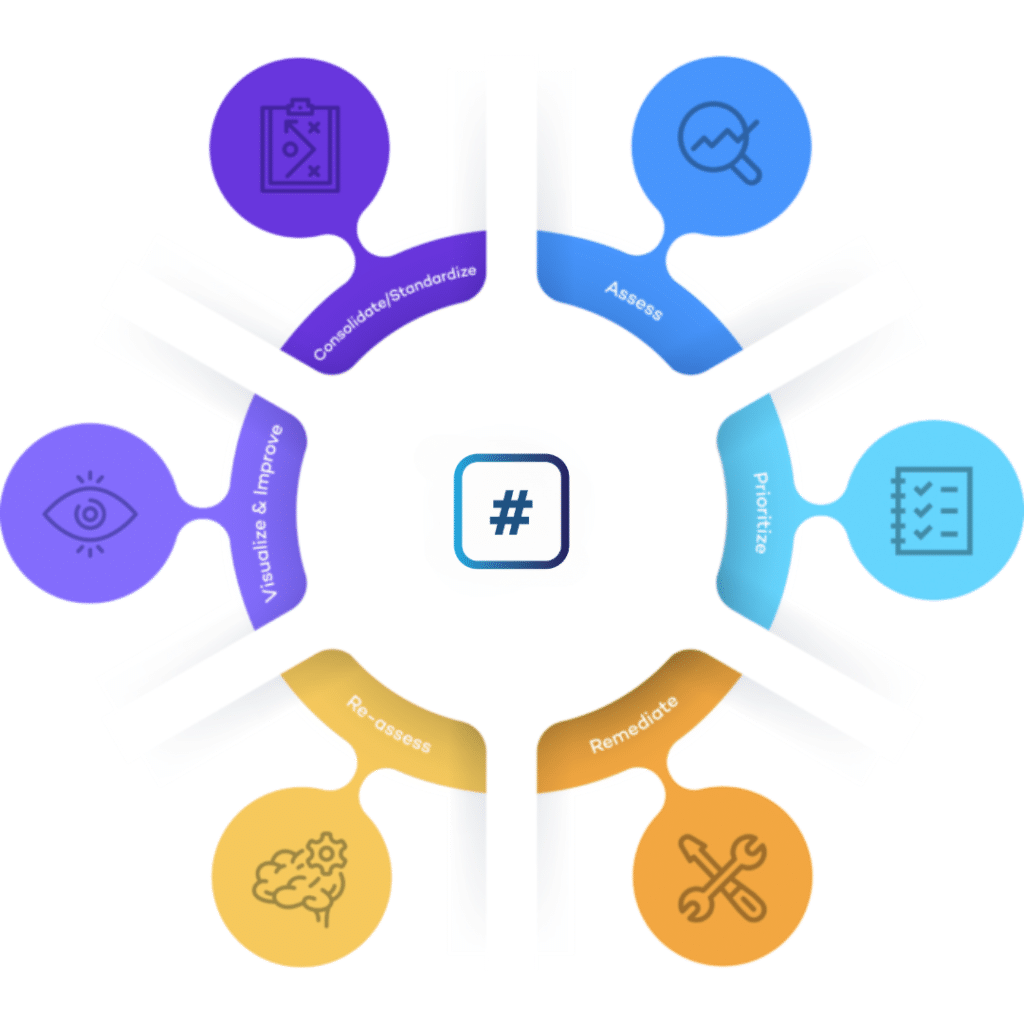The vulnerability management process consists of the actions required for an IT security team to remediate security vulnerabilities within their organization’s network.
An effective vulnerability management process should be continuous, intelligence-driven, and streamlined to enable teams to remediate as effectively as possible.
Vulnerability management solutions like The Rootshell Platform help organizations modernize their vulnerability management processes and improve remediation from start to finish.
What is Vulnerability Management?
Vulnerability management is the cyclical process of identifying, evaluating, prioritizing, and remediating security flaws within an organization’s network, systems, and applications.
The goal of a vulnerability management process is to ensure that organizations have complete visibility and control of weaknesses that exist within their IT estates, on a continuous basis.
Vulnerability management is not to be confused with a vulnerability assessment. Vulnerability management encompasses the end-to-end process of managing security issues, from discovery to remediation. On the other hand, a vulnerability assessment is a type of IT security test that discovers security issues within an organization’s network.
Why is the Vulnerability Management Process Important?
Vulnerability management is an essential part of an organization’s IT security strategy. Without an effective vulnerability management process, an organization’s data, personnel, and reputation could be at risk.
Implementing a vulnerability management process helps IT security teams ensure that critical issues are discovered, analysed, and remediated before they can be exploited. This ensures that teams can minimize their organization’s attack surface and reduce the chance of cyberattacks.
Vulnerability management phases also help organizations allocate resources more effectively. Not all security vulnerabilities pose the same risk, and many may not even need to be remediated. A good vulnerability management process helps security teams assess and prioritize vulnerabilities most effectively, so organizations can ensure that resources are suitably allocated.
Another reason why vulnerability management is so important is that an organization’s threat landscape is ever-changing. Your vulnerability management process should be cyclical, so that IT security teams can continuously be aware of evolving threats.
What is the Vulnerability Management Process?
The vulnerability management steps starts with the discovery of security issues, and conclude with validating whether remediation has been successful, before repeating continuously.
We summarize the vulnerability management process as follows:
- Discover: Identify threats and vulnerabilities within your organization’s network by carrying out regular penetration tests and vulnerability scans.
- Consolidate: Centralize your threat and vulnerability assessment results in one place. A vulnerability management tool can make this process effortless.
- Assess: Analyse your security issues in line with cyber threat intelligence, such as exploit databases, to establish their severity, the likelihood that they will be exploited, and the impact they could have on your organization.
- Prioritize: Assign severity scores to your assets in line with your analysis, and other factors such as resource availability.
- Remediate: Carry out your vulnerability management process to resolve vulnerabilities in line with your organization’s priorities.
- Re-assess: Verify whether your remediation efforts have been successful. Ultimately, your vulnerability management process should reduce business risk.
- Visualize and improve: Continuously improve your vulnerability management process; resolve any bottlenecks and ensure compliance with your organization’s service level agreements. For example, could you reduce your time-to-remediate (TTR)?

Best Practices for your Vulnerability Management Process
Continuous Vulnerability Management Processes
The time between security assessments is the time when your organization could be at risk. Your vulnerability management process should be an ongoing process to close these gaps.
Intelligence-led
An intelligence-driven approach to vulnerability management enables IT security teams to gain essential context of their issues, prioritize most effectively, and accurately evaluate risk. Read more on vulnerability intelligence.
Streamlined
Bottlenecks within threat and vulnerability management processes can lose you precious time. Processes should be streamlined, empowering teams to address issues fast and efficiently.
What are Vulnerability Management Tools?
Vulnerability management tools can help IT security teams improve a wide range of processes within vulnerability management, from data analysis and reporting, to project management and collaboration, and much more.
Many different tools can aid specific parts of the vulnerability management process, such as ticketing systems to assign remediation tasks, and spreadsheets to track open issues.
However, dedicated Vulnerability Remediation Management tools consolidate these different functionalities in one place, as well as providing features specific to improving remediation, such as reducing time-to-remediate (TTR).
Modernize your Vulnerability Management Process With Rootshell Platform
Here are just some of the ways The Rootshell Platform makes it effortless to implement an effective vulnerability management process.
- Consolidate Your Supplier Assessment Data: Import any assessment result into Rootshell; store data from any penetration testing vendor or security service provider in one centralized hub.
- Integrate and Standardize Your Assessment Data: Generate a database for your results in one consistent format. No longer analyse assessment results in silos; view data from different threat assessments alongside each other.
- Contextualize and Prioritize Your Assessment Data: Rootshell’s industry-leading Active Exploit Detection automatically alerts you to active exploits for your issues on a daily basis, so you can gain the context needed to prioritize most effectively.
- Streamline Your Remediation Workflow: Make remediation faster and more efficient, with third-party integrations, collaboration tools, real-time updates from testers, and more.
- Track and Validate Your Remediation Results: Measure your remediation efforts against your service level agreements and track key metrics, such as your monthly remediation rate.
- Visualize and Analyse Technical Risk Across the Whole Organization: Gain a holistic view of your global threat landscape; effortlessly analyse your technical risk with insightful dashboards and automated reporting.
Subscribe So You Never Miss an Update




